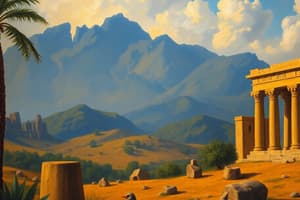Podcast
Questions and Answers
ଦ୍ବିତୀୟ ବିଶ୍ୱୟୁଦ୍ଧ ଶେଷ ହୋଇଥିବା ବର୍ଷ କେଉଁଟି?
ଦ୍ବିତୀୟ ବିଶ୍ୱୟୁଦ୍ଧ ଶେଷ ହୋଇଥିବା ବର୍ଷ କେଉଁଟି?
- 1947
- 1944
- 1943
- 1945 (correct)
କେଉଁଟା ଦ୍ବିତୀୟ ବିଶ୍ୱୟୁଦ୍ଧର ଏକ ମୁଖ୍ୟ ଅବିକାଶ?
କେଉଁଟା ଦ୍ବିତୀୟ ବିଶ୍ୱୟୁଦ୍ଧର ଏକ ମୁଖ୍ୟ ଅବିକାଶ?
- ଏଥିଏ ରାଜନୈତିକ କ୍ଷେତ୍ରରେ ଶକ୍ତିଗତ ସାଧାରଣ ସମ୍ପ୍ରେଷଣ
- ସ୍ଥାୟୀ ସାମରିକ କାର୍ଯ୍ୟ
- ନିକଟବର୍ତ୍ତୀ ଓ ବ୍ରହ୍ମସ୍ପତି
- ପରমাণୁ ବମ୍ବ ବ୍ୟବହାର (correct)
କୌଣସି ଦେଶ ଦ୍ବିତୀୟ ବିଶ୍ୱୟୁଦ୍ଧର ଅକ୍ଷ ଶକ୍ତିର ଅଂଶ ଥିଲା?
କୌଣସି ଦେଶ ଦ୍ବିତୀୟ ବିଶ୍ୱୟୁଦ୍ଧର ଅକ୍ଷ ଶକ୍ତିର ଅଂଶ ଥିଲା?
- ସଂଯୁକ୍ତ ରାଜ୍ୟ
- ଇଂଲଣ୍ଡ
- ଜର୍ମାନୀ (correct)
- କାନାଡା
ଦ୍ବିତୀୟ ବିଶ୍ୱୟୁଦ୍ଧର ସମୟରେ ଜ୍ୟାପାନରେ କେଉଁ ସଂଘଟନ ହୋଇଥିଲା?
ଦ୍ବିତୀୟ ବିଶ୍ୱୟୁଦ୍ଧର ସମୟରେ ଜ୍ୟାପାନରେ କେଉଁ ସଂଘଟନ ହୋଇଥିଲା?
ତାଲିବାନୀ ଶକ୍ତି ଗଢା ପଡିଥିଲା କୋର୍ବେ ଥିବାଙ୍କୁ କି ଧରାକରଣ ଥିଲା?
ତାଲିବାନୀ ଶକ୍ତି ଗଢା ପଡିଥିଲା କୋର୍ବେ ଥିବାଙ୍କୁ କି ଧରାକରଣ ଥିଲା?
ମେସୋପୋଟାମିଆର ସାମ୍ପ୍ରଦାୟିକ ତଥ୍ୟକୁ କଣ କୁହାଯାଏ?
ମେସୋପୋଟାମିଆର ସାମ୍ପ୍ରଦାୟିକ ତଥ୍ୟକୁ କଣ କୁହାଯାଏ?
ପ୍ରାଚୀନ ମିଶରର ରାଜାଙ୍କୁ କି ସୂଚିତ କରାଯାଏ?
ପ୍ରାଚୀନ ମିଶରର ରାଜାଙ୍କୁ କି ସୂଚିତ କରାଯାଏ?
ଗ୍ରୀସରେ କି କ୍ଷେତ୍ରରେ ତଥ୍ୟ ପ୍ରଦାନ କରାଯାଇଛି?
ଗ୍ରୀସରେ କି କ୍ଷେତ୍ରରେ ତଥ୍ୟ ପ୍ରଦାନ କରାଯାଇଛି?
ରୋମର ମହାନ୍ତା କେଂହାକି ସୂଚିତ କରାଯାଏ?
ରୋମର ମହାନ୍ତା କେଂହାକି ସୂଚିତ କରାଯାଏ?
ବିଶ୍ୱ ଯୁଦ୍ଧ I କେଉଁ ବାଲକୁ ସୂଚିତ କରେ?
ବିଶ୍ୱ ଯୁଦ୍ଧ I କେଉଁ ବାଲକୁ ସୂଚିତ କରେ?
ଗାଟ ଯୁଦ୍ଧରେ ଆଖିକ୍ଷେତ୍ର ଗ୍ରହଣ କସେ ବସ୍ତୁ ରହିଥିଲା?
ଗାଟ ଯୁଦ୍ଧରେ ଆଖିକ୍ଷେତ୍ର ଗ୍ରହଣ କସେ ବସ୍ତୁ ରହିଥିଲା?
ଜୁଲିୟସ ସୀଜାର କିନ୍ନା କୌଣସି ସମ୍ପର୍କକୁ ବିକାଶ କରିଥିଲେ?
ଜୁଲିୟସ ସୀଜାର କିନ୍ନା କୌଣସି ସମ୍ପର୍କକୁ ବିକାଶ କରିଥିଲେ?
Flashcards
ଦ୍ୱିତୀୟ ବିଶ୍ୱଯୁଦ୍ଧ
ଦ୍ୱିତୀୟ ବିଶ୍ୱଯୁଦ୍ଧ
୧୯୩୯ରୁ ୧୯୪୫ ମଧ୍ୟରେ ଘଟିଥିବା ଏକ ବିଶ୍ୱବ୍ୟାପୀ ଯୁଦ୍ଧ, ଯେଉଁଥିରେ ବିଶ୍ୱର ବହୁତ ଶକ୍ତିଶାଳୀ ଦେଶ ମିଳିତ ଓ ଅକ୍ସିସ୍ ପକ୍ଷରେ ଭାଗ ନେଇଥିଲା।
ପରମାଣୁ ବୋମା
ପରମାଣୁ ବୋମା
ଦ୍ୱିତୀୟ ବିଶ୍ୱଯୁଦ୍ଧରେ ବ୍ୟବହୃତ ଏକ ଅତ୍ୟନ୍ତ ଶକ୍ତିଶାଳୀ ଅସ୍ତ୍ର।
ହିଟ୍ଲର
ହିଟ୍ଲର
ଜର୍ମାନୀର ଫାସିବାଦୀ ନେତା।
ଅକ୍ସିସ୍ ଦଳ
ଅକ୍ସିସ୍ ଦଳ
Signup and view all the flashcards
ମିଳିତ ଦଳ
ମିଳିତ ଦଳ
Signup and view all the flashcards
ହଲୋକାଉଷ୍ଟ
ହଲୋକାଉଷ୍ଟ
Signup and view all the flashcards
ମେସୋପୋଟାମିଆ
ମେସୋପୋଟାମିଆ
Signup and view all the flashcards
ପ୍ରାଚୀନ ମିଶର
ପ୍ରାଚୀନ ମିଶର
Signup and view all the flashcards
ପ୍ରାଚୀନ ଗ୍ରୀସ
ପ୍ରାଚୀନ ଗ୍ରୀସ
Signup and view all the flashcards
ପ୍ରାଚୀନ ରୋମ
ପ୍ରାଚୀନ ରୋମ
Signup and view all the flashcards
ମାୟା ସଭ୍ୟତା
ମାୟା ସଭ୍ୟତା
Signup and view all the flashcards
ପ୍ରଥମ ବିଶ୍ୱଯୁଦ୍ଧ
ପ୍ରଥମ ବିଶ୍ୱଯୁଦ୍ଧ
Signup and view all the flashcards
ପ୍ରଥମ ବିଶ୍ୱଯୁଦ୍ଧର କାରଣ
ପ୍ରଥମ ବିଶ୍ୱଯୁଦ୍ଧର କାରଣ
Signup and view all the flashcards
Study Notes
Ancient Civilizations
-
Mesopotamia: Located between the Tigris and Euphrates rivers, Mesopotamia (meaning "land between the rivers") was a cradle of civilization. Known for its city-states, including Ur and Babylon, it developed complex irrigation systems, cuneiform writing, and impressive architectural feats like ziggurats. Key figures include Hammurabi, known for his legal code.
-
Ancient Egypt: Developed along the Nile River, Egypt boasted a highly organized society with a complex belief system centered around the afterlife. Pharaohs ruled as divine kings, overseeing monumental pyramids and elaborate tomb complexes. Achievements include hieroglyphics, advanced mathematics, and sophisticated medical practices.
-
Ancient Greece: A collection of city-states, Greece fostered democracy, philosophy, and the arts. Notable figures include Socrates, Plato, and Aristotle. Greek city-states like Athens and Sparta engaged in warfare, and Greek civilization significantly influenced later Western cultures, particularly in their political systems, literature, and philosophy.
-
Ancient Rome: Initially a small city-state, Rome rose to become a vast empire encompassing much of Europe, North Africa, and the Middle East. Roman law, engineering (aqueducts, roads), and military organization provided a model for later empires. Julius Caesar and Augustus were key figures in Rome's expansion and transformation.
-
Mayan Civilization: Flourished in Mesoamerica, the Maya developed a sophisticated calendar system, hieroglyphic writing, and impressive city-states like Tikal. They excelled in mathematics and astronomy. The cause of their decline remains debated.
World Wars
-
World War I (1914-1918): Caused by a complex mix of political tensions, imperialism, and nationalism, WWI involved major European powers. The assassination of Archduke Franz Ferdinand triggered a chain reaction. The war employed trench warfare on the Western Front, marked by devastating casualties, technological advancements in weaponry (e.g., tanks and airplanes), and global involvement, including the entry of the United States.
-
Causes of World War I: The complex web of alliances, imperial rivalries, and nationalistic fervor in Europe fueled the outbreak. A pivotal event involved the assassination of Archduke Franz Ferdinand, heir to the Austro-Hungarian throne.
-
World War II (1939-1945): A global conflict, WWII involved much of the world's major powers, divided into Allied and Axis factions. Fueled by aggressive expansionism, the war began with Nazi Germany's invasion of Poland and soon encompassed much of Europe, Asia, and the Pacific. The Holocaust, a systematic genocide of Jews, is a significant aspect of the war, along with the use of atomic bombs by the United States on Japan.
-
World War II Key Themes: The rise of totalitarian regimes in Germany, Italy, and Japan is a crucial factor. The war's global scale is a defining feature, with significant involvement from both European powers and newly formed alliances. Military strategies varied across different theaters. Technological advancements in warfare, culminating in the use of atomic bombs, were pivotal. The war led to substantial geopolitical shifts and the establishment of the United Nations.
Studying That Suits You
Use AI to generate personalized quizzes and flashcards to suit your learning preferences.




